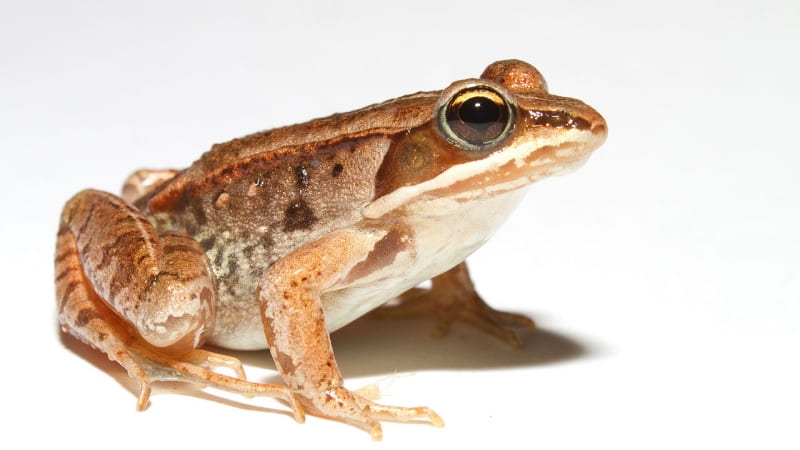NATURE’S MYSTERIES: FROG FREEZE & THAW
By: Carolyn Wilke

Wood frog image accessed from Wikimedia Commons, taken by biologist Brian Gratwicke.
Spring is here. In the forests of the Midwest, frogs are waking from their hibernation. Many of these frogs, including the spring peeper (Pseudaris crucifer) and the wood frog (Rana sylvatica), hibernate below the bark of trees or beneath leaf litter on the forest floor. As cold-blooded animals, they need heat from outside sources to maintain their body temperature. When the temperature drops, these frogs freeze.
Though it sounds simple to freeze for winter and thaw for spring, surviving while frozen is not easy. In humans, extreme cold leads to frostbite, freezing our tissues, and causing permanent damage when especially severe. To survive, animals need to protect their cells from these dangers. Frogs and other freeze-tolerant amphibians and reptiles, like some snakes, newts, and turtle hatchlings, walk a biochemical tightrope to survive at low temperatures.
Just as water in your ice cube tray expands as it solidifies, the water inside a cell expands as it freezes. This expansion changes the cell volume and can damage its structure. Frogs avoid damaging ice inside cells by pushing up to 65% of their water outside their cells. The water then freezes in pockets below their skin around their skeletal muscles. However, moving the water outside the cells also comes with perils.
When water is removed from cells, any dissolved components, or solutes, are left behind and become more concentrated. The high concentration of solutes can damage the cell, even destroying proteins. The difference in solute concentrations inside and outside the cell leads to a force called osmotic pressure, that pushes on the cell wall. Similar to how air pressure can cause an overinflated balloon to pop, very high solute concentrations in a cell can build osmotic pressure and cause the cell membrane to rupture.
Frogs overcome this challenge by making common molecules, including glucose, the type of sugar in our own blood, that protect the frog cells’ volume. These molecules are termed cryoprotectants because they protect against the “cryo,” which simply means cold. Cryoprotectants work by changing the colligative properties of the fluids inside the frog cells.
Colligative properties occur when a compound is dissolved into a liquid at such a high concentration that it changes the properties of the liquid. During winter, we use colligative properties to keep our roads from icing over: we cover them in salt. The salt dissolves in the water and lowers its freezing point. In the frog’s body, the high concentration of glucose acts as a natural anti-freeze that prevents the volume of the cell from changing too much. Triggered by the ice buildup under their skin, frogs make glucose by taking glycogen—one of the building blocks of body tissue—from their livers and turning it into glucose.
Frogs also need to regulate their bodily processes—heartbeat, breathing, and blood circulation—during the freezing. When completely frozen, the frog has no breathing or heartbeat; the lack of blood flow deprives the frog’s organs of oxygen. Oxygen is generally necessary for metabolism, the chemical reactions that sustain the body and provide it energy. Frogs slow their metabolism while they are frozen, becoming somewhat dormant and using less energy. They still require some energy to survive so their organs use stored fuel and switch to metabolic reactions that do not need oxygen. In this hibernation state, with much of their body’s water turned to ice and their metabolism slowed, they can survive for many weeks to make it through the coldest part of the winter.
When the warmth of spring thaws the frogs, their first sign of renewed life is a restored heartbeat. Breathing and blood flow starts again. The glucose that protected the frog from the dangers of freezing returns to the liver where it can be converted back to tissue. The frogs emerge from their hiding spots, with the warm temperatures now signaling them that their next phase of life–mating and reproduction–has arrived.
